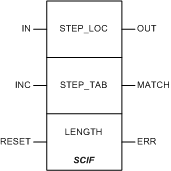|
|
(Original Document)
|
|
Name in LL984 Editor
|
Function Block Name
|
|---|---|
|
name of legacy 984 instruction
|
name in other tools and editors like:
|
 |
 |

|
Input Pin
|
Name
|
Data Type
|
Address Range
|
Meaning
|
|---|---|---|---|---|
|
Top
|
IN
|
–
|
ON = initiates specified sequence control operation
|
|
|
Middle
|
INC
|
BOOL
|
–
|
Drum mode: step pointer increments to the next step
ICMP mode: compare status is shown at MATCH
|
|
Bottom
|
RESET
|
BOOL
|
–
|
Drum mode: ON = reset step pointer to 0
ICMP mode: not used
|
|
Node
|
Node Type
|
Name
|
Data Type
|
Address Range
|
Meaning
|
|---|---|---|---|---|---|
|
Top
|
IN/OUT
|
STEP_LOC
|
UINT
|
%MW
|
step pointer
number of the current step in the step data table
|
|
Middle
|
IN/OUT
|
STEP_TAB
|
ANY_ARRAY_UINT
|
%MW
|
step data table
first word in the step data table
For more infomation see below.
|
|
Bottom
|
IN
|
LENGTH
|
UINT
|
1 ... 255
|
length of step data table
The integer value entered in LENGTH is the length, i.e. the number of application-specific words, used in the step data table. The length can range from 1 ... 255.
The total number of words required in the step data table is the length + 6.
|
|
Output Pin
|
Name
|
Data Type
|
Address Range
|
Meaning
|
|---|---|---|---|---|
|
Top
|
OUT
|
BOOL
|
–
|
ON = specified sequence control operation initiated
(Echoes the status of the IN input).
|
|
Middle
|
MATCH
|
BOOL
|
–
|
In drum mode: The output MATCH goes ON for the last step.
In ICMP mode: The output MATCH goes ON to indicate a valid input comparison.
Note: When using MATCH, be aware that when integrating with other logic, if the step pointer is zero and INC is ON, then MATCH will also be ON. This condition will cause the step pointer to be one step out of sequence.
|
|
Bottom
|
ERR
|
BOOL
|
–
|
ON = error is detected
|
|
Word
|
Name
|
Description
|
|---|---|---|
|
1
|
subfunction type
|
0 = drum mode; 1 = ICMP mode
(entry of any other value in this word will result in all outputs OFF)
|
|
2
|
masked output data
(in drum mode)
|
loaded by SCIF each time the block is solved
The word contains the contents of the current step data word masked with the output mask word.
|
|
raw input data
(in ICMP mode)
|
loaded by the user from a group of sequential inputs to be used by the block in the current step
|
|
|
3
|
current step data
|
loaded by SCIF each time the block is solved
The word contains data from the current step (pointed to by the step pointer).
|
|
4
|
output mask
(in drum mode)
|
loaded by the user before using the block
The contents will not be altered during logic solving.
contains a mask to be applied to the data for each sequencer step
|
|
input mask
(in ICMP mode)
|
loaded by the user before using the block
It contains a mask to be ANDed with raw input data for each step, masked bits will not be compared. The masked data are put in the masked input data word.
|
|
|
5
|
masked input data
(in ICMP mode)
|
loaded by SCIF each time the block is solved
It contains the result of the ANDed input mask and raw input data.
|
|
not used in drum mode
|
-
|
|
|
6
|
compare status
(in ICMP mode)
|
loaded by SCIF each time the block is solved
It contains the result of an XOR of the masked input data and the masked current step data. Unmasked inputs that are not in the correct logical state cause the associated word bit to go to 1. Non-zero bits cause a miscompare and output MATCH will turn off.
|
|
not used in drum mode
|
-
|
|
|
7
|
start of data table
|
first of 6 LENGTH words in the table containing the user-specified control data
Note: This and the rest of the words represent application-specific step data in the process being controlled.
|